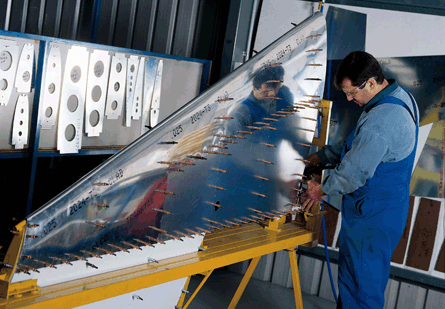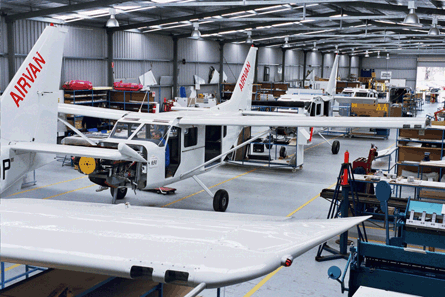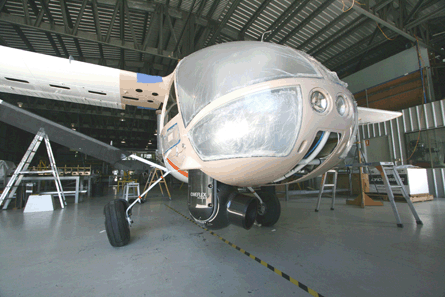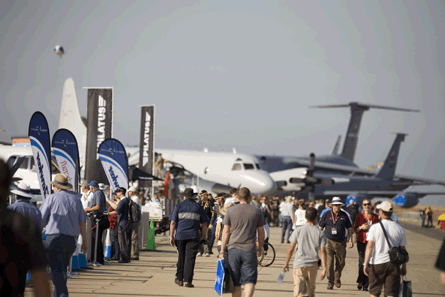Perseverance is the watchword when it comes to Australia's aerospace and defence industry, which is striving for footholds in global programmes.
Australian companies, universities and research bodies have found success in a number of niche areas, including component manufacture, composites, unmanned air vehicles, hypersonics, general aviation aircraft and air traffic management.
Two Victoria-based component and tooling suppliers, Marand Precision Engineering and Production Parts, for example, are both involved in international programmes, but success has not come quickly.
"Over 25 years ago, we recognised the need to diversify from the automotive industry and now we've been working with Hawker de Havilland/Boeing Aerostructures Australia for that long," says David Ellul, managing director of Moorabbin-based Marand. "We've built a reputation over a long period of time."
 |
|---|
© GippsAeroGippsAero has delivered more than 150 of its GA8 Airvan utility turboprops around the world |
Aerospace now accounts for 60% of Marand's business. The aerospace tooling sector has been solid for Marand over the past few years, with the company securing work on the Lockheed Martin F-35 Joint Strike Fighter and Boeing 787. Marand has exported more than 400 tools to Lockheed, for example.
In 2003, Marand became the first company to win a JSF ground support equipment contract from Lockheed.
Marand has been responsible for the design and manufacture of the JSF engine removal and installation trailer, the first of which was handed over in 2005. Some Australian companies have been hit hard by F-35 delays, but much of Marand's work has been at the front end of the programme.
It is also supplying F-35 vertical tails to BAE Systems, with first deliveries scheduled for the end of 2013. That work will be conducted at a new Geelong facility that Marand plans to establish next year. The company employs 180, with a further 300 required for the new facility, says Ellul.
Marand's success with Lockheed, in particular, has developed over years. "We do the initial work well and leverage off that to take us into a new area with the customer," says Ellul. "Aerospace and defence primes want to work with companies with a track record."
Synergies derive from Marand's automotive track record. Tom Burbage, executive vice-president F-35 programmes, visited Marand early on in the life of the programme and was taken to Ford's Australian plant for a viewing of Marand's robotic automation production solutions. "Lockheed Martin saw a capability here - both in technology and business," says Ellul.
Marand is also supplying tooling and an automated production system to Boeing Aerostructures Australia's Melbourne facility for the 787, and is generally looking to build on its civil work. "We like being here - in Australia - and we think it can be made to work, but you have to add something intellectually to make it work here," says Ellul.
Production Parts, meanwhile, is diversifying into commercial aerospace, having established a pedigree in component manufacture, precision assembly and systems integration on defence programmes. The Melbourne-based company is making its civil debut by supplying Boeing 747 landing-gear components.
"Commercial work offers a great opportunity for us," says managing director Peter Nicholls. Production Parts, which employs 75 people, is now quoting on Boeing 737 work. Nicholls recently visited Japan to explore 787 opportunities.
Like Marand, Production Parts has won a number of JSF contracts, to manufacture airframe components for Lockheed Martin and Northrop Grumman, actuation products for Parker, and engine parts for Pratt & Whitney and General Electric. It started work in 2010 on manufacture of the high compressor case for the P&W F135 engine. The contract has a potential value of A$40 million ($40.1 million).
 |
|---|
© GippsAeroA $20 million investment by Mahindra will allow extra production of GippsAero's Airvan |
Like many, the company has been affected by F-35 delays and the global financial crisis, concedes Nicholls. But he is optimistic for the year ahead. Production Parts' order book has reached record levels thanks largely to a multimillion-dollar, four-year contract to supply rudder pedal kits for the Boeing F/A-18E/F Super Hornet.
It also has multimillion-dollar orders from Eurocopter for components for the Tiger armed reconnaissance helicopter and MRH90 multi-role helicopter, and is supplying spare parts for the Boeing KC-135 tanker.
What lies behind these successes? "Perseverance, listening to customer requirements, talking to the government about policies that support the local industry: all of these are important," says Nicholls.
On the other side of the country in Perth, Western Australia, composite manufacturer Quickstep is at last finding international success after years of promoting itself and its capabilities. In addition to traditional autoclave manufacture of composites, Quickstep has developed the "Quickstep Process", a fluid-based curing method for the manufacture of high-strength and lightweight composite materials using a rigid mould suspended in heat transfer liquids. Quickstep has been demonstrating its capabilities to primes and tier-one manufacturers for the past 10 years and established subsidiaries in Germany and the USA to get close to the majors, as well as alliances with universities in Australia and the UK.
That work has paid off. Earlier this month, Quickstep secured a A$700 million long-term agreement with Northrop Grumman to manufacture up to 16 different F-35 components, contributing an annual turnover of A$50 million by 2015. The work will initially use the autoclave method but could later involve the Quickstep Process, Quickstep hopes.
To fulfil the contract, Quickstep is moving to the former Boeing Aerostructures Australia facility at Sydney Bankstown in New South Wales and increasing its workforce from 40 to 400, hoping to employ former Boeing skilled personnel available after the airframer's consolidation in Melbourne. Quickstep intends to become "the largest independent aerospace composites manufacturer in Australia", says chief executive Philippe Odouard.
Discussions on further work opportunities for Quickstep could accelerate now the Northrop Grumman deal is in place. For example, it has a JSF memorandum of understanding with Marand for up to A$50 million worth of contracts to manufacture vertical tail skins.
"We have a team of experienced international executives that have an understanding of how to do business outside Australia," says Odouard. "Also, we have two subsidiaries - one in Germany and one in the US - that service those markets on a day-to-day basis."
The government's Global Supply Chain (GSC) programme, launched in 2009, is facilitating opportunities for local industry to serve primes. Under the programme, primes are required to develop company-specific programmes to evaluate Australian suppliers for participation in their supply chains.
In addition, the Defence Export Unit has helped Australian companies win contracts worth in excess of A$550 million, while the Defence Industry Innovation Centre is striving to help local companies become export ready.
Boeing's Office of Australian Industry Capability (OAIC) was the first organisation of its kind under the GSC initiative. It was established in 2007 to identify small and medium-sized enterprises and bring them into the US giant's supply chain. Boeing says the OAIC has delivered contracts worth more than $190 million to local industry, with 10 SMEs competing for extra Boeing work worth $260 million.
Through the OAIC, Boeing has provided local companies with training and mentoring to help them develop the knowledge and skills needed to compete globally. Boeing itself employs more than 2,800 at 28 sites throughout Australia - the manufacturer's largest operational footprint outside the USA.
Local SMEs Mincham Aviation, Ferra Engineering and Production Parts have all benefited from the OAIC. While Production Parts secured its Super Hornet rudder pedal contract, South Australia-based Mincham was selected to manufacture assembly spare part sets for the Boeing CH-47 Chinook programme, and Brisbane-based Ferra Engineering - competing against 20 suppliers globally - won a 747 machined components contract. "The OAIC has really helped us," says Nicholls.
The OAIC model is now being rolled out across other major aerospace manufacturers: BAE Systems, Raytheon, Thales and, most recently, Lockheed Martin. State governments, such as Victoria, are also working closely with local aerospace SMEs to push their capabilities to the primes. Victoria's industry, for example, has secured 60% of Australia's JSF business to date, says Peter Haddad, strategic adviser at the state government's defence industry unit.
The Victorian government is the only state with representatives in London, Frankfurt and Washington, acting as "the voice for local companies" to identify aerospace opportunities. Some believe more needs to be done at federal level. "We still need policies to encourage local content. The government really needs to focus on that as we are competing on a very uneven playing field," says one Australian supplier. Another asserts: "Other countries drive a very hard bargain when buying aerospace products. In aerospace terms we're small but we have the capability. We really need the investment and strategy to be engaged."
Australian companies are not just focused on big aerospace programmes, but have found success in niche sectors: in GA, for example. GippsAero (formerly Gippsland Aeronautics) has delivered more than 150 of its GA8 Airvan utility turboprops around the world.
The company launched in the 1970s as an aircraft maintenance and modification business, and moved into aircraft production in the early 1990s. After its acquisition by India's Mahindra Group in 2009, the company has funding for its next stage of development, with Mahindra to invest $20 million over the next two years. This will allow a ramp-up of production of the Airvan, the launch of a 10-seat stretch - dubbed the GA10 - and a relaunch of Nomad, the 18-seat GA18.
Seabird Aviation also focuses on a niche. The Hervey Bay, Queensland-based was established in 1983 by Don Adams and his son Peter. Its fixed-wing, two-seater Seeker patrol and surveillance aircraft is operated by customers in Australia, Azerbaijan, Iraq, Jordan, South Africa, Tanzania, UAE and the USA.
The aircraft is manufactured in Hervey Bay and, under licence, by Seabird Aviation Jordan and Seabird Aviation America in Albuquerque, New Mexico. In a bid to "revolutionise" airborne surveying, the manufacturer has recently launched a redesigned Seeker.
 |
|---|
© Seabird Aviation |
This has new engines for improved hot and high performance, an increased maximum take-off weight and structural modifications and a glass cockpit. "We recognised long ago that we had to address a need in the GA field that really wasn't being looked at very much," says managing director Peter Adams. "It's fortunate that patrol and surveillance was the niche we decided to try to fill. It's becoming more and more apparent that this was a correct decision." He adds: "The old axiom that you must differentiate does apply. The Airvan is successful because it's a good aeroplane that fills a gap in the market. We are doing our best to achieve this same result... We have for many years worked hard to break into international markets. It has been evident that unless a successful record of domestic sales could be demonstrated, these international markets would be difficult to penetrate."
Air traffic management is another area where Australian companies have sought to demonstrate expertise. Thales Australia started out with 10-15 people working in ATM 15 years ago, but today has around 430 staff in Melbourne, where it has chosen to locate its ATM centre of excellence.
The unit is intended as the "export engine of Thales Australia", says Martin Ripple, vice-president and air operations business unit managing director.
"When we started working here we found the skills, had a number of successes, had a good relationship with the government and our customer [Airservices Australia]. It's the environment that makes you grow."
Thales has built a strong ATM customer base in the Asia-Pacific region from Australia. Its Centre for Advanced Studies in Air Traffic Management, which will be responsible for developing next-generation ATM technology for the global market, is to be officially launched at the Avalon air show in March.Australia is a long way from the major aerospace centres of the world.
The strength of the Australian dollar recently has not helped local suppliers, but the nation's companies are nonetheless finding success on the global stage - and looking ahead optimistically as the grip of the global financial crisis loosens.
VICTORIA'S AEROSPACE EMPIRE
There are pockets of aerospace and defence industry activity throughout Australia, but historically the largest centre of aerospace manufacturing has been in Victoria, primarily in and around the state capital Melbourne.
The Victorian government says it has more than 500 aerospace and aviation companies employing over 22,000 highly skilled staff. In 2009-10, the state's defence sector exported 24% of goods and services, valued at A$226 million ($226.5 million). In addition to a number of primes, Victoria is home to many small and medium enterprises, as well as a thriving research and development sector, which includes the Australian Advanced Manufacturing Research Centre, Cooperative Research Centre for Advanced Composites Structure, Defence Science and Technology Organisation, Defence Science Institute and Defence Materials Technology Centre.
 |
|---|
© Victorian GovernmentDalla-Riva (left) dismisses the "softly, softly" approach |
Some state governments, notably those of New South Wales, Queensland and South Australia, have begun to recognise the value of the aerospace industry and have attracted aerospace companies, often with generous assistance packages. The most recent example is composites manufacturer Quickstep, born and bred in Western Australia but moving to New South Wales with support from that state's government and to take advantage of a ready pool of skilled workers, following Boeing Aerostructures Australia's consolidation of its activities in Melbourne. New South Wales has committed A$75 million to boost its defence industry, aiming to secure 30% of Australia's home defence spend by 2019.
The new state government of Victoria is keen to maintain its strength and will no longer welcome its aerospace activities being poached by other states. "We have a clear policy position on the aviation industry, with a strong focus on defence," says Richard Dalla-Riva, Victoria's minister for employment and industrial relations, as well as manufacturing, exports and trade. As part of its commitment, the government is to confirm a strategic direction for the sector at next month's Avalon air show.
Victoria has had "an insufficient focus on the industry and has been slow to recognise opportunities", the government concedes. The "softly, softly" approach to its aerospace manufacturing industry is a thing of the past and the new government will take "a very aggressive approach", says Dalla-Riva.
It also plans to strengthen its Defence Industry Unit to "aggressively target opportunities for investment and employment within the defence industry".
GETTING IN ON THE GROUND FLOOR
Research and development is vital for Australia to maintain and grow any sort of aerospace industry with access to international supply chains. Accordingly, its research organisations are at the forefront of global developments in their fields.
The University of Queensland, for example, has pioneered the country's hypersonics programme and is a world leader in the field; the Australian Research Centre for Aerospace Automation is at the forefront of developing and testing technologies to allow the efficient and safe utilisation of airspace by manned and unmanned aircraft through its Smart Skies project; and the Co-operative Research Centre for Advanced Composite Structures (CRC-ACS) has pioneered composite design and manufacturing technologies that have allowed Australian enterprises to become global players.
The CRC-ACS was established in 1991 under the federal government's CRC programme and has secured funding, in its fourth and final round, for a five-year international research programme. The CRC-ACS has 28 participating organisations, with more international participation than ever, including EADS, German research centre DLR and universities in France and the UK.
The CRC's work programme until mid-2015 comprises eight projects, spanning plant fibre biocomposites, rapid assembly methods, systems for crashworthiness, composites fire performance, robust composite repairs, structure repair and rehabilitation, and systems development for structural health monitoring.
R&D is a means of gaining early access to international programmes. "I'm convinced if you do not engage with overseas primes early on you have no hope of having a stake in big programmes," says Professor Murray Scott, chief executive of CRC-ACS as well as managing director of ACS Australia - the new arm of the organisation tasked with commercialising its technologies.
CRC-ACS has worked with 50 or 60 companies on technology transfer work. In the early days, the CRC worked closely with Hawker de Havilland (now Boeing Aerostructures Australia) on new technologies to design, analyse and manufacture advanced composite components, which resulted in the company being awarded the contract to construct all wing trailing edge devices for the 787 - potentially worth A$4 billion ($4 billion) in exports.
Ballaratt-based Regina Glass Fibre - with its fire resistant tissue for composites, FireShield, developed with the CRC-ACS - is also a success story, says Scott.
A CRC-ACS technology that Scott predicts will be "a minor revolution" for the future is thermoset composite welding, in which Airbus, for example, is interested. This allows rapid assembly of carbon/epoxy components through the use of a special layer of thermoplastic in the surface of components to be joined during layup. "It's new and we have a heap of patents," says Scott. "We are totally confident in this technology."
Scott is clear on how Australia's aerospace industry will prosper: "Technology is the only way forward. We have to compete on cost and technology and that only comes through investment in R&D."
AVALON GETS READY TO MARK MULTIPLE MILESTONES
This year's Australian International Airshow, to take place at Melbourne's Avalon airport in Victoria from 1-6 March, comes as the country's aerospace and defence industry passes a number of major milestones.
The show coincides with the Royal Australian Air Force celebrating its 90th anniversary; the local airline industry commemorating a century of paid passenger flight in the country; and the show celebrating its 10th appearance at Avalon.
 |
|---|
© Australian International AirshowMore aircraft will be displayed in the static park than in 2009 |
This year's show will maintain the same exhibition footprint as two years ago, while the number of aircraft in the static park is up on 2009, says Ian Honnery, air show chief executive. Despite the global financial crisis, international representation is strong, with increased participation from France, Italy and Switzerland. The UK's presence is slightly down, but that of the USA remains about the same.
The static display is particularly boosted by a larger number of business jets and executive aircraft, highlighting the growth of this sector in Australia.
Unmanned air vehicles will be a focus of the show, having their own demonstration area for the first time, says Honnery.
Alternative aviation fuels, ageing aircraft and sustainment will also be on the agenda.
Source: Flight International



















